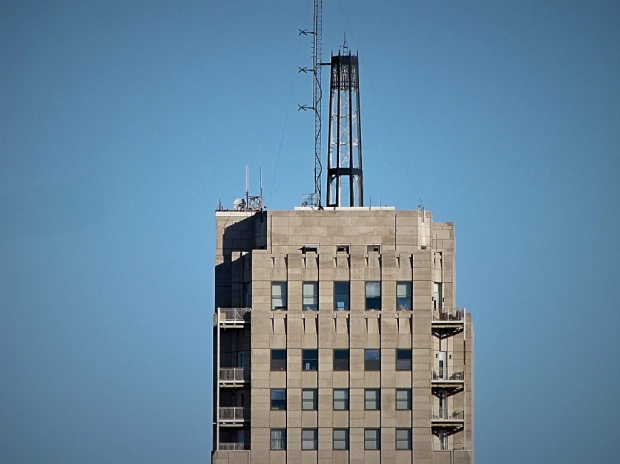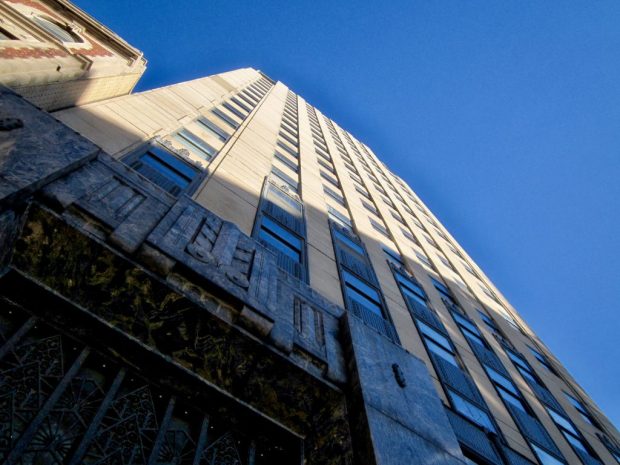
Was the spire atop the Wisconsin Tower, 606 W. Wisconsin Ave., intended for mooring giant passenger airships like the Hindenburg? When this building was built in 1920, that wasn’t a far-fetched idea. Carl A. Swanson photo
According to legend, the owners of the 22-story Wisconsin Tower (originally the Mariner Tower), built 88 years ago at 606 W. Wisconsin Ave., included something unusual in its design – a rooftop mooring mast for dirigible airships. In drawing up plans in the late 1920s builders pinned their hopes on the latest development in transportation – airships. With a dirigible mooring mast on the roof, 280 feet above the street it was just a matter of time before Zeppelins linked Milwaukee, via this very building, to the major cities of the world.

At 22 stories, the Wisconsin Tower was the second tallest in the city when completed in 1930. Carl A. Swanson photo
It’s a good story, but is it true? In 2006, a writer for the Milwaukee Journal Sentinel researched the matter and even examined the 35-foot steel “mooring mast” on the tower’s roof. He found no evidence of an airship dock. (The rooftop structure is decorative. Originally encased in glass, it was illuminated at night.)
The Wisconsin Tower Condominium Resident’s Handbook sounds a similar note, “Although there has been speculation that the steel tower’s original purpose was for blimp landings, there is no proof.”
An airship mooring tower on a circa-1930 building would not be a farfetched idea. New York’s 102-story Empire State Building, built at about the same time, had rooftop mooring facilities. The 1929 Thomas Jefferson Hotel in Birmingham, Alabama, still retains its mooring mast. There is even a ticket office and waiting room atop Cleveland’s Huntington Building, built in 1924.
Airships docked by coupling to a mooring tower using a linkage at the tip of the craft’s nose, secure but free to pivot as the wind shifted. Passenger access was via drop-down stairs from the nose.
Of the three buildings, only the Empire State Building’s mooring was ever used, and the only successful docking (by a small blimp) required white-knuckle maneuvering.
For its part, the Zeppelin company wanted nothing to do with the concept. According to a 2010 article in the New York Times, “Dr. Hugo Eckener, the commander of the Graf Zeppelin and the world’s expert on dirigibles, said flatly that the Empire State project was not practical. Zeppelin landings required scores of ground crewmen, retaining ropes fore and aft, and even then landings were sometimes dicey.”
The Graf Zeppelin was 800 feet long and very, very delicate, being made mostly of millions of cubic feet of extremely flammable hydrogen gas covered by a thin layer of fabric.
Although skyscraper mooring could be done there seems little chance airship operators could ever be enticed to sidle up to the Wisconsin Tower.
Otherwise, the Wisconsin Tower had plenty to offer. A 1933 advertisement in the Milwaukee Journal listed the advantages of “the finest and most modern office building in Milwaukee.” They included: Excellent parking, a large conference room and library for use of all tenants, available shower baths for tenants, elevators within 40 feet of all offices, and heat controls in every room.
Airship mooring is conspicuously absent from the list of features even though Zeppelins were still sedately cruising the globe when that 1933 advertisement appeared. The Hindenburg disaster, which ended the era of commercial airship travel, was still four years in the future – in 1937.
If the original design included an airship docking mast, the owners may have lacked the money to install the feature.

The Wisconsin Tower was planned in the late 1920s but construction was slowed by the onset of the Great Depression. Carl A. Swanson collection
Construction of the Wisconsin Tower started in 1929, the same year as the stock market crash and the start of the Great Depression. Financial trouble set in with a vengeance within months when the building was half-finished. By 1939, delinquent on taxes and behind on land payments, the still-uncompleted tower went into receivership.
The Wisconsin Tower was eventually completed and fully occupied in the late 1940s, long after the era of the airships. The tower’s 650 stockholders finally received their first dividend checks in 1949 – 20 years after the work started.
But the tale never entirely faded from the city’s imagination. People still point to the Wisconsin Tower and talk of airships.
There is another story connected with this building – early in its construction the builder accidentally transferred ownership of the land under the building to the city.
It happened this way: The Wisconsin Tower was originally called the Mariner Tower until its 1939 financial reorganization. It was named for John W. Mariner, a real estate developer who, interestingly, grew up in a house located at Milwaukee Street and Juneau Avenue previously owned by city founder Solomon Juneau. While John Mariner was growing up, his father was busy acquiring tracts of land around the city. One of his lots, the northwest corner of Sixth Street and Wisconsin Avenue, would become the site of the future Mariner Tower.
In 1928, Mariner granted a 99-year land lease to John Saxe. John and his brother Thomas controlled Saxe Amusement Enterprises, then a leading chain of movie theaters. (The Oriental Theater on North Farwell Avenue was built by the Saxe chain.) Before construction of the Mariner Tower started, John Saxe transferred a 30-foot-wide strip of land along the east side of the lot to the city to accommodate the widening of Sixth Street.
But in writing up the easement, a clerk in Saxe’s office mistakenly used a legal description that encompassed much of the property, thereby giving the city title to land valued, in 1930 dollars, at $1.5 million. The mistake only discovered after construction was well underway. An embarrassed Saxe had to ask City Hall to give back his land.
Lost Milwaukee, a new book from The History Press containing the very best from Milwaukee Notebook, is now available. Click here for more details.

Originally offices, the Milwaukee Tower became condominiums in 2004 but retains much of its original Art Deco details. Carl A. Swanson photo

Kick! Thanks again, Carl, for another great article about my birthplace. Milwaukee Art Deco dirigible buildings rock! LIN-Z
LikeLiked by 1 person
I live at the Wisconsin Tower! Thanks for the great article.
LikeLike